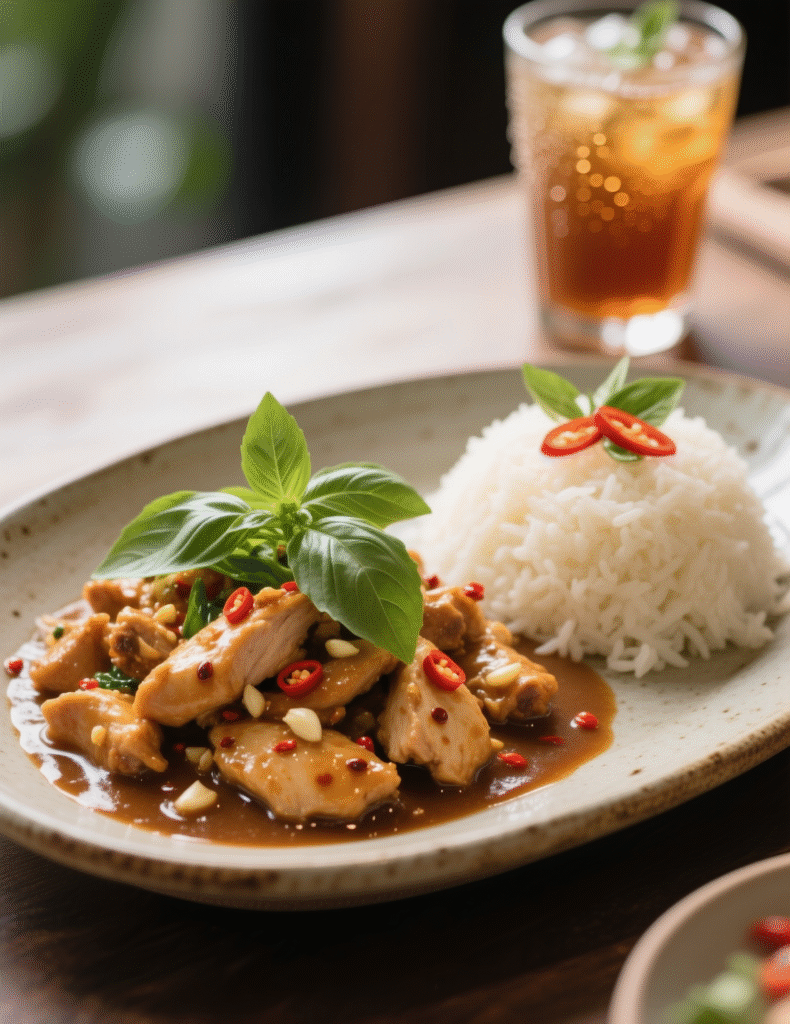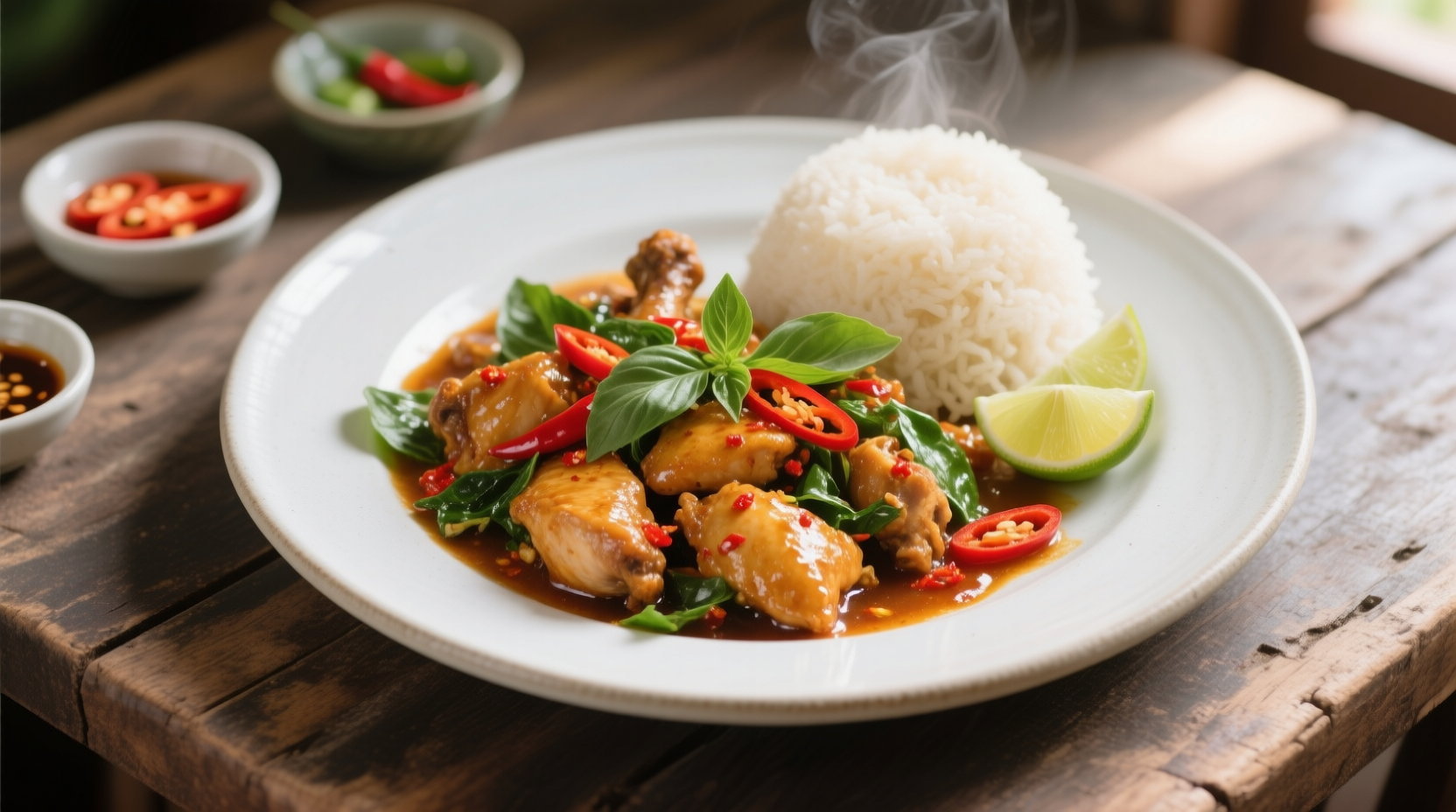It’s not just a stir-fry. Thai Basil Chicken, or Pad Kra Pao Gai if you want to say it like a Bangkok street vendor, is a dish that hums with urgency. The aroma, the speed, the balance—every part of it works in seconds, yet every second matters. Done right, it’s the kind of recipe that turns a home kitchen into a small temple of sizzling woks and dancing basil leaves.
I’ve cooked versions of this dish in professional kitchens, on clunky electric stoves in apartments, and on portable gas burners in Bangkok alleys. Each time, the process has felt like chasing a train that refuses to slow down. And the thing is—you don’t want it to slow down. You want the heat, the rush, the smoke.
Understanding the Core of Thai Basil Chicken
Professionals know this: in Thai cooking, the real magic isn’t just in the ingredients. It’s in the ratio of heat to time to seasoning. Pad Kra Pao is about speed—too slow and you lose that just-charred edge; too fast and you don’t let the aromatics bloom.
At its heart, this dish uses Thai holy basil (Ocimum tenuiflorum)—not sweet Italian basil, not even Thai sweet basil. Holy basil has a peppery, almost clove-like edge that refuses to be polite. If you swap it, you’ll get a tasty dish, sure, but it won’t be this dish.
Then there’s the sauce—fish sauce, oyster sauce, soy, and just a hint of sugar. Each one carries weight. The fish sauce? That’s the umami backbone. The oyster sauce? Body and gloss. Soy sauce? A dark, salty shadow that makes everything richer. Sugar? It’s not for sweetness—it’s to pull the edges together, like lacing up a shoe.
Ingredient Deep Dive for Professionals
If you’re building this for a restaurant menu or testing for consistency, here’s what to lock down:
- Chicken: Thigh meat is king here. More fat, more flavor, more forgiveness. Mince it yourself with a cleaver instead of relying on pre-ground—better texture, and you control the fat ratio.
- Garlic & Chili: Thai bird’s eye chilies are traditional. You can adjust heat for your crowd, but the garlic should stay plentiful—about 5–6 cloves for two servings, smashed, not finely chopped. This releases oils that hold flavor better in the wok’s heat.
- Holy Basil: Always add it off the heat. Basil hates long cooking—it bruises, wilts, and loses aroma. Toss it at the end, just enough for the leaves to hit the steam and release their oil.
- Sauce Mix: Pre-mix the sauce. Professionals don’t pour each element in separately over the wok—it wastes time, risks imbalance, and can scorch one liquid before the rest hits.
A small note for those sourcing in bulk: fresh holy basil has a shorter shelf life than sweet basil, sometimes less than 48 hours post-harvest. Train your kitchen team to rotate stock daily or source from a grower who cuts to order.

Wok Science and Heat Management
Thai street vendors use jet burners that sound like small dragons breathing. You probably don’t. If you’re on standard kitchen gas or induction, you have to compensate. The trick is batch size.
Crowding the pan drops the temperature and forces steaming instead of searing. For two servings, you need no more than 250–300g chicken in a 14-inch wok. Any more and you’ll start stewing the meat in its own juices.
A carbon steel wok, seasoned and thin-walled, is best for this recipe. The quick heat transfer means garlic and chili go from raw to aromatic in under 15 seconds. If it takes longer, your wok’s not hot enough, or you’ve added the aromatics too early.
Step-by-Step Professional Method
1. Prep Like You Mean It
Every ingredient must be ready before heat touches metal. Chicken minced and portioned. Garlic and chili pounded into a coarse paste. Sauce mixed and waiting. Basil washed, spun dry, and leaves separated. This isn’t a slow cooker dish—you will not have time to chop in the middle.
2. Heat and Aromatics
Wok over high flame until just smoking. A tablespoon of neutral oil—rice bran or canola—goes in. Garlic-chili paste drops into the center. Stir for 10–15 seconds, just enough for noses in the kitchen to turn toward the wok.
3. Protein In
Chicken hits the wok. Smash it down briefly to maximize surface contact, then stir constantly. You want the edges to brown in small patches while the inside stays moist.
4. Sauce and Balance
Pour in the pre-mixed sauce. The moment it hits, the wok will sizzle violently, and the aroma will jump up like it’s trying to escape the kitchen. Keep tossing for 30–45 seconds until the sauce clings to the chicken.
5. Basil and Finish
Turn off the heat. Throw in basil. Toss until the leaves wilt from the residual steam—about 10 seconds. Serve immediately over hot jasmine rice, ideally topped with a crispy fried egg (kai dao) for that proper street-side authenticity.
Common Professional Mistakes and How to Dodge Them
- Using sweet basil instead of holy basil: The flavor balance shifts dramatically, losing the dish’s bite.
- Cooking basil too long: This kills both aroma and color.
- Overcrowding the wok: Leads to steaming, pale meat, and thin sauce.
- Skipping the sauce pre-mix: Results in uneven seasoning and possible burnt sugars.
- Using chicken breast: Possible, yes, but much less forgiving in heat management—tends to go dry.

Nutritional and Menu Insights
For restaurant menus, Thai Basil Chicken is versatile. It works as a main with rice, in lettuce wraps for lighter fare, or even as a topping for rice noodles. Nutritionally, with thigh meat, each serving sits around 320–350 kcal (excluding rice), with high protein and moderate fat. Adjust the fat by trimming meat more aggressively or swapping part of the portion with minced mushroom for a plant-meat hybrid—something that’s been trending in Bangkok cafés since 2023.
If catering to heat-sensitive audiences, halve the chilies and add a small pinch of white pepper—it keeps the warmth without the sharp burn.
Cultural Notes and Authenticity Considerations
Thai Basil Chicken is not a “sweet” Thai dish, despite what Western takeout menus sometimes show. In Thailand, it’s savory, slightly salty, with a heat level that wakes you up mid-bite. Sweetness is present but subtle, more a counterbalance than a main character.
And yes—this is street food. It’s not served with broccoli florets or baby corn in Bangkok. Those are Westernized adaptations. The real dish is lean: chicken, basil, garlic, chili, sauce. Nothing else.
Advanced Variations for Professionals
- Duck Basil Stir-Fry: Swap chicken for minced duck leg meat. Richer flavor, needs a touch more sugar to balance the fat.
- Crispy Pork Basil (Pad Kra Pao Moo Krob): Use deep-fried pork belly slices instead of chicken. Add sauce after the pork is crisp to avoid sogginess.
- Vegan Basil Stir-Fry: Replace meat with minced oyster mushrooms and firm tofu. Double the basil to compensate for the lighter flavor profile.
Each variation still respects the holy basil’s role—never losing that defining peppery edge.
Emerging Trends in Thai Basil Chicken Presentation
In Bangkok’s newer cafés, you’ll see plating that’s half traditional, half Instagram bait. Fried egg with a runny yolk is perched like a crown. Basil leaves are placed deliberately instead of tossed. And sometimes, rice is shaped into neat cylinders or domes.
While purists might scoff, these trends cater to the reality of modern diners—people eat with their eyes first, and dishes that photograph well tend to sell more. Data from food delivery platforms in Thailand shows that photos featuring a bright green basil leaf and golden egg yolk get 17–23% higher click-through rates.
Final Notes for Perfecting the Dish
Thai Basil Chicken is as much about rhythm as it is about flavor. The steps move fast, but each has a precise reason. A professional understands that—heat, timing, and basil handling are the difference between something good and something unforgettable.
If you run a kitchen, train your cooks to feel the moment basil should hit the pan, to hear the right sizzle when sauce meets meat, to smell when garlic is ready. These sensory cues are worth more than any printed recipe.
And when you plate it, serve it hot. Not warm, not lukewarm—hot enough that the steam still carries basil’s perfume. That’s the moment where the dish, no matter how far from Bangkok, feels like Bangkok.
FAQs
What is Thai Basil Chicken?
It’s a classic Thai stir-fry made with minced chicken, holy basil, garlic, chilies, and a savory sauce.
Can I use sweet basil instead of holy basil?
You can, but it will change the flavor and lose the peppery kick of authentic holy basil.
What cut of chicken works best?
Boneless chicken thighs are ideal for their juiciness and richer flavor.
How spicy is Thai Basil Chicken?
Traditionally it’s quite spicy, but you can reduce bird’s eye chilies for a milder version.
Can I make it vegetarian or vegan?
Yes, replace chicken with tofu or mushrooms and adjust the sauce for plant-based needs.
Do I need a wok to cook it?
A wok is best for high-heat searing, but a large skillet works if preheated well.
Why pre-mix the sauce?
It ensures even seasoning and prevents burning of individual ingredients.
When should I add the basil?
Add it off the heat at the very end to preserve aroma and color.
What’s the best rice to serve with it?
Steamed jasmine rice is the traditional and most complementary choice.
Can I make it ahead of time?
It’s best cooked fresh, as basil wilts and flavor fades quickly after cooking.

Mariana is a passionate home cook who creates delicious, easy-to-follow recipes for busy people. From energizing breakfasts to satisfying dinners and indulgent desserts, her dishes are designed to fuel both your body and hustle.
When she’s not in the kitchen, she’s exploring new flavors and dreaming up her next recipe to share with the Foodie Hustle community.

